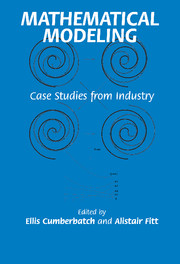Book contents
- Frontmatter
- Contents
- Contributors
- Preface
- Introduction
- 0 Mathematical Preliminaries
- 1 Fluid-Mechanical Modelling of the Scroll Compressor
- 2 Determining the Viscosity of a Carbon Paste Used in Smelting
- 3 The Vibrating Element Densitometer
- 4 Acoustic Emission from Damaged FRP-Hoop-Wrapped Cylinders
- 5 Modelling the Cooking of a Single Cereal Grain
- 6 Epidemic Waves in Animal Populations: A Case Study
- 7 Dynamics of Automotive Catalytic Converters
- 8 Analysis of an Endothermic Reaction in a Packed Column
- 9 Simulation of the Temperature Behaviour of Hot Glass during Cooling
- 10 Water Equilibration in Vapor-Diffusion Crystal Growth
- 11 Modelling of Quasi-Static and Dynamic Load Responses of Filled Viscoelastic Materials
- 12 A Gasdynamic–Acoustic Model of a Bird Scare Gun
- 13 Paper Tension Variations in a Printing Press
- Index
8 - Analysis of an Endothermic Reaction in a Packed Column
Published online by Cambridge University Press: 05 June 2012
- Frontmatter
- Contents
- Contributors
- Preface
- Introduction
- 0 Mathematical Preliminaries
- 1 Fluid-Mechanical Modelling of the Scroll Compressor
- 2 Determining the Viscosity of a Carbon Paste Used in Smelting
- 3 The Vibrating Element Densitometer
- 4 Acoustic Emission from Damaged FRP-Hoop-Wrapped Cylinders
- 5 Modelling the Cooking of a Single Cereal Grain
- 6 Epidemic Waves in Animal Populations: A Case Study
- 7 Dynamics of Automotive Catalytic Converters
- 8 Analysis of an Endothermic Reaction in a Packed Column
- 9 Simulation of the Temperature Behaviour of Hot Glass during Cooling
- 10 Water Equilibration in Vapor-Diffusion Crystal Growth
- 11 Modelling of Quasi-Static and Dynamic Load Responses of Filled Viscoelastic Materials
- 12 A Gasdynamic–Acoustic Model of a Bird Scare Gun
- 13 Paper Tension Variations in a Printing Press
- Index
Summary
Introduction
In 1977 the British Steel Corporation presented a problem to the European Study Groups for Industry, concerning the analysis of a gas–solid reaction in a column packed with solid catalyst pellets. This is an industrial problem of common concern, arising in various kinds of reactor such as a blast furnace. BSC were coy about the details of the reaction involved, but were happy to provide details of relevant physical parameters, essential for any analysis, and this allowed for a fairly thorough study of the problem.
Much of the applied mathematical interest in this type of problem has been motivated by the occurrence of exothermic reactions, i.e. those which release heat, as multiple steady states may exist for such reactions, and the associated phenomenon of thermal runaway can occur. However, the BSC problem concerned an endothermic reaction, one which absorbed heat, and our challenge thus lay in seeking some analytical understanding of the dynamics of the reaction.
The specific problem as summarised by BSC was as follows:
The problem is to solve two simultaneous partial differential equations. Although a method has been found using finite differences, the method is very slow in convergence and the boundary conditions have to be solved by an indirect manner. This is because the boundary conditions are dependent on an external radiative heat transfer problem. It would be very useful if an alternative approach to the problem was available in which the external heat transfer problem and the partial differential equations were formulated as a single problem.
Information
- Type
- Chapter
- Information
- Mathematical ModelingCase Studies from Industry, pp. 160 - 180Publisher: Cambridge University PressPrint publication year: 2001
